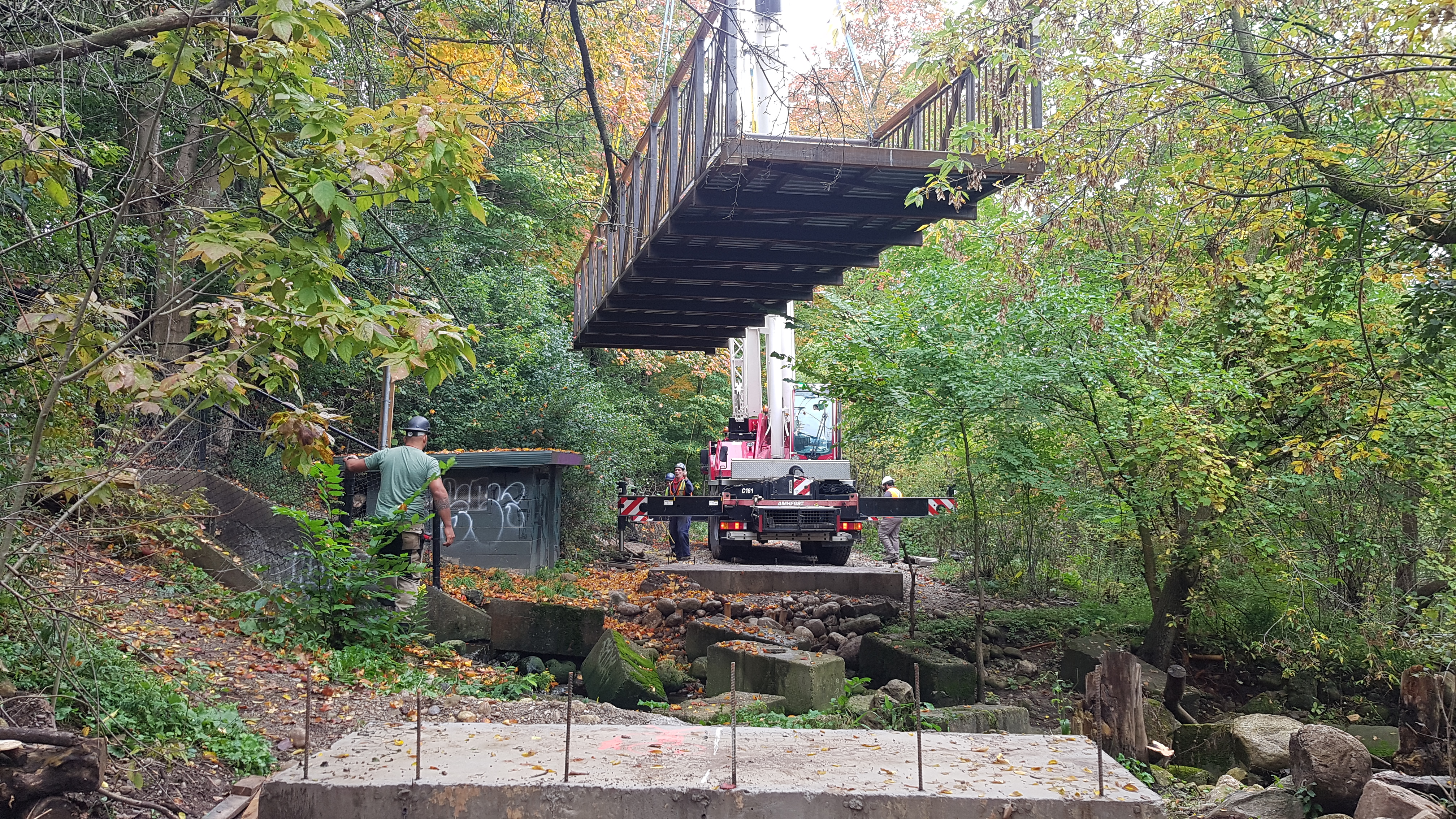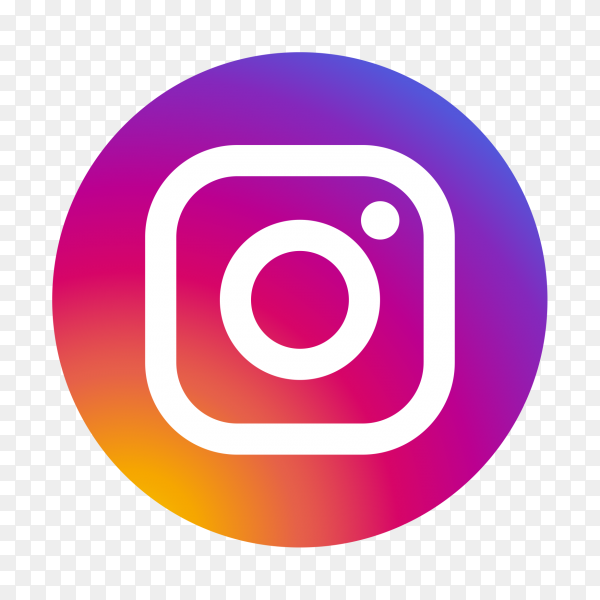|
- Home
- Trails
- Year of the Bridges
- Gosling Bridge
Gosling Bridge
By Liam Waterman, GHTC Volunteer

See more photos here!
The Gosling Bridge is a multi-use steel bridge spanning a storm water crossing on the James Street Trail, a recreational path maintained by the Guelph Hiking Trail Club (GHTC) connecting their Radial Line Trail (RLT) to the City of Guelph. The bridge was constructed under the supervision of project manager Lorenz Calgano (also president of the Speed River Cycling Club) as the culmination of a collaborative fundraising campaign organized by several volunteer groups in the Guelph area, including the GHTC, the Speed River Cycling Club (SRCC), the Guelph Victors Running Club (GVRC), the Guelph Off Road Biking Association (GORBA), and the Guelph Coalition for Active Transportation (GCAT). The Gosling Bridge has remained a symbol of the power of community initiatives, making the surrounding trail both safer and more accessible for a wide range of users.1
Though the GHTC has maintained the RLT since it was constructed by the club in 1971, they only took over maintenance of the James Street Trail in 2013, when they signed a formal agreement with the University of Guelph, the owner of the property.2 The trail follows the line of the former Toronto Suburban Railway as it leads directly into the city alongside the Eramosa river. The storm water outlet was already present when the GHTC took over the trail, and, prior to the installation of the Gosling Bridge, had presented a serious safety risk to recreational users. The crossing was too wide to be jumped or stepped across directly, requiring users to hop across a series of large concrete blocks located in the path of the drain. These blocks had been placed by the City in order to reduce the strength of the water flowing into the Eramosa river, and were not intended for foot traffic. They could become particularly slippery in the winter or springtime, when they were frequently covered with ice or water. Users had created a makeshift path up the hillside around the drain in order to avoid this obstacle, but this route was also relatively precarious. By the time John Fisher took over as president of the GHTC in 2019 it was clear that some kind of permanent structure would be needed to bridge the crossing.
In that year the GHTC contacted both the University of Guelph and the City of Guelph regarding the possibility of installing a bridge over the storm water outlet. The GHTC’s agreement with the University had stipulated that they would be responsible for mitigating any safety risks on the trail, and the prospect of making the James Street Trail more accessible was consistent with the GHTC’s goal at the time of connecting all their trail systems to the core of the City of Guelph. While neither the university nor the City were interested in taking an active role in the project, they both gave the GHTC permission to begin planning for bridge construction themselves. Lorenz Calgano, president of the SRCC, was also interested at the time in installing a bridge over the storm water outlet, desiring to make the path more accessible for cyclists. He first contacted City staff, who then redirected him to the GHTC. Calgano met with president of the GHTC John Fisher and former president Bill Mungall in 2019 to discuss plans for the bridge. While the GHTC had envisioned installing a simple wooden bridge suitable for hikers, Lorenz and the SRCC pushed for a larger metal bridge, which would allow cyclists to cross without dismounting. Fisher noted at the time that a more significant structure would require more financial support. As part of the planning process, Fisher and the GHTC organized a meeting in the former Guelph Public Library on Norfolk street with a variety of local community groups, including members from the SSRC, GHTC, GORBA, GVRC, and GCAT. Many of these groups supported Calgano’s plan for a larger and more accessible metal bridge, and Lorenz Calgano was made project manager for the prospective bridge.
Lorenz’ initial plans involved drawing on his engineering connections to build the bridge at relatively low expense. The distribution company Hunter Steel, whose founder Mark Hunter was a board member with GORBA, had offered to supply steel for bridge construction. Will Tyrone, a local civil engineer, had also agreed to help with engineering. The ballpark estimate for the cost of this plan was $20,000, which would still require significant fundraising. Lorenz notes that this version of the bridge would not necessarily have fit all of the clubs’ desired criteria for the bridge, and would have required regular maintenance and painting in the years following its installation. These plans were changed in 2020, in part due to the success of the fundraising campaign, but also largely owing to the outbreak of the COVID-19 pandemic. As Ontario’s public health guidelines came to recommend physical distancing to mitigate the spread of infection, it became important to install a bridge wide enough that two people could walk abreast while still maintaining a reasonable amount of space between them. For a larger and more elaborate steel bridge, Lorenz and the GHTC eventually decided to purchase a prefabricated steel bridge from Eagle Bridges Inc., a bridge-building company located in Kitchener. The GHTC had already gone to them several times before, notably for the Musagetes and Stonefields bridges on the Kissing Bridge Trail. The GHTC’s executives appreciated the fact that Eagle Bridges Inc. would handle the delivery and installation of the bridge, which would make the project much easier for the involved community groups.
In order to pay for this Eagle bridge, the GHTC recognized that significantly more funding would be necessary. To raise money for the project, the involved community groups undertook a peer-to-peer fundraising campaign, in which each group would be responsible for procuring donations from their members with the idea being that the groups could compete amongst each other to see which one could raise the most. The GHTC also posted an online request for donations through Canada Helps, which allowed donors from outside the Guelph area to easily contribute. Art Kilgour, a graphic designer, member of the GVRC, and campaign funds manager for the Gosling Bridge, was responsible for creating promotional material, which included a number of street signs posted at locations including Wellington road.
Several large donations were also obtained to fill out the budget for the bridge, which eventually reached a final number of $85,000. Don O’Leary, the former Vice President of Finance at the University of Guelph, had recommended before his retirement in 2020 that the University donate $25,000 to the GHTC to aid in their general efforts, all of which was put towards the bridge. Lorenz Calgano also had a connection with Stan Kozak, the executive director of the Gosling Foundation, an organization created by Dr. Philip Gosling to support conservation efforts and protect natural spaces.3 The Gosling Foundation donated $15,000.4 Two government grants made up the final large donations. The first of these was procured by Lorenz’s partner Meg Gilman, who set up an application to a federal grant provided under the Canada Healthy Communities Initiative. The second was a Guelph Community Grant received from the City of Guelph. Lorenz notes that these large donations were instrumental in supporting the GHTC’s peer-to-peer fundraising program, demonstrating to prospective donors that the club would be able to reach its financial goal for the project.
With fundraising underway, construction on the project began in 2021. Richard Charity, a local general contractor, was enlisted by Lorenz to construct the concrete abutments. The first step in this process for Charity and his crew was to dig out sufficiently large trenches on either side of the drain, within which the abutments would be formed. Staff from the City of Guelph were concerned by the proximity of the initial proposed locations of the abutments to sewer and gas lines that ran underneath the trail on the western side of the drain, and thus demanded that the abutments be moved further away from the storm water outlet. The City also mandated that the abutments be dug by hand on the western side in order to avoid accidentally striking these lines. Since the crew was already required to dig the abutments by hand on the eastern side, due to the impossibility of bringing vehicles over the uncovered drain, this wasn’t considered a significant impediment. Nonetheless, digging did become a relatively labor intensive task; the holes needed to be five feet deep to fit the abutments, and the soil next to the river bed was particularly compacted and rocky.
Once digging was finally completed, concrete was poured into forms placed within the trenches to shape the abutments, which were reinforced with rebar. The trail remained open for use during this process, at Lorenz’ direction. In order to allow users to pass by the construction area, members of the Guelph Off Road Biking Association (GORBA) created a short new side trail leading up the slope around the drain. Lorenz Calgano recalls being particularly impressed at their technique; “these guys know how to make trails. They’re the best in town”.5 Their work involved bench cutting the new trail, which means moving earth from the higher side of a slope onto the lower side in order to create a flat surface. This trail allowed users to easily and safely bypass the drain. The bridge itself was installed on October 5th, 2021; Eagle Bridges Inc. delivered the bridge on the back of a flatbed truck, which was driven down the trail to location from Gordon street. They also brought a crane, which was used to lift the bridge onto its abutments. Prior to this event Lorenz had worked with volunteers to trim back the bush on either side of the James Street Trail, creating the space needed to bring machinery through. Once the bridge was put in place, it was bolted down, and new concrete aprons were constructed around it to prevent any direct contact between the metal from the bridge and the trail surface. After this, bridge construction was finished.

A grand opening for the new “Gosling Bridge,” named in reference to the generous donation provided by the Gosling Foundation, was held on November 20th 2021.6 Phil Gosling himself attended this event, along with a number of members from the different community organizations involved in the project. A plaque was installed on the trail next to the bridge, listing the names of all the donors who had made the project possible. Beyond simply mitigating an existing safety risk, the presence of the Gosling Bridge has made the James Street Trail significantly more accessible to a wide range of users. The trail’s flat, compact surface makes it suitable for individuals with limited mobility, or those with mobility aids such as canes or wheelchairs. The only obstacle present on the trail for such groups had formerly been the storm water crossing; now, a wide range of people who formerly would have had to simply turn around at the channel, including small children and the elderly, are able to use the trail in its entirety. The success of the Gosling Bridge project demonstrates the extent of what community efforts, including collaborations between community volunteer organizations, can achieve.
Notes
1. Much of the information in this article was procured through in person interviews with John Fisher, July 2023, and Lorenz Calgano, August 2023. Many thanks to both of them for their help in this project.
2. “President’s Report as of Jan 23, 2013”, Minutes, Newsletters, Handbooks, Posters, Scrapbooks, Correspondence and Other Items Relating to the Guelph Hiking Trail Club, 1970-, McLaughlin Library, University of Guelph.
3. “Home”, The Gosling Foundation, https://goslingfoundation.org/.
4. “The New James Street Trail Bridge will be named ‘The Gosling Bridge’”, Guelph Hiking Trail Club, https://www.guelphhiking.com/event-4266571.
5. In conversation with the author, August 2023.
6. “Gosling Bridge Officially Open”, Guelph Hiking Trail Club, https://guelphhiking.com/Gosling-Bridge.


